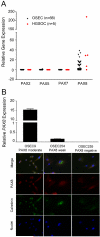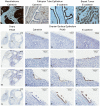PAX8 expression in ovarian surface epithelial cells
- PMID: 26079312
- PMCID: PMC4951208
- DOI: 10.1016/j.humpath.2015.03.017
PAX8 expression in ovarian surface epithelial cells
Abstract
High-grade serous ovarian carcinoma (HGSOC) is usually diagnosed at a late stage and is associated with poor prognosis. Understanding early stage disease biology is essential in developing clinical biomarkers to detect HGSOC earlier. While recent studies indicate that HGSOCs arise from fallopian tube secretory epithelial cells, a considerable body of evidence suggests that HGSOC can also arise from ovarian surface epithelial cells (OSECs). PAX8 is overexpressed in HGSOCs and expressed in fallopian tube secretory epithelial cells, but there are conflicting reports about PAX8 expression in OSECs. The purposes of this study were to comprehensively characterize PAX8 expression in a large series of OSECs and to investigate the role of PAX8 in early HGSOC development. PAX8 protein expression was analyzed in the OSECs of 27 normal ovaries and 7 primary OSEC cultures using immunohistochemistry and immunofluorescent cytochemistry. PAX8 messenger RNA expression was quantified in 66 primary OSEC cultures. Cellular transformation was evaluated in OSECs expressing a PAX8 construct. PAX8 was expressed by 44% to 71% of OSECs. Calretinin and E-cadherin were frequently coexpressed with PAX8. Expression of PAX8 in OSECs decreased cellular migration (P = .028), but had no other effects on cellular transformation. In addition, PAX8 expression was significantly increased (P = .003) in an in vitro stepwise model of neoplastic transformation. In conclusion, PAX8 is frequently expressed by OSECs, and endogenous levels of PAX8 expression are non-transforming. These data indicate that in OSECs, PAX8 expression may represent a normal state and that OSECs may represent an origin of HGSOCs.
Keywords: CMYC; Fallopian tube epithelial cells; High-grade serous ovarian carcinoma; Inclusion cyst; Ovarian surface epithelium; PAX8.
Copyright © 2015 Elsevier Inc. All rights reserved.
Figures




References
-
- Bell DA, Scully RE. Early de novo ovarian carcinoma. A study of fourteen cases. Cancer. 1994;73:1859–64. - PubMed
-
- Auersperg N. Ovarian surface epithelium as a source of ovarian cancers: unwarranted speculation or evidence-based hypothesis? Gynecol Oncol. 2013;130:246–51. - PubMed
-
- Przybycin CG, Kurman RJ, Ronnett BM, Shihle M, Vang R. Are all pelvic (nonuterine) serous carcinomas of tubal origin? Am J Surg Pathol. 2010;34:1407–16. - PubMed
Publication types
MeSH terms
Substances
Grants and funding
LinkOut - more resources
Full Text Sources
Other Literature Sources
Medical
Miscellaneous

